Introduction
This document describes how to configure and troubleshoot Ring-No-Answer (RONA) with Cisco Customer Voice Portal (CVP) and Contact Center Enterprise (CCE).
Prerequisites
Requirements
Cisco recommends that you have knowledge of these topics:
- Cisco Unified Customer Voice Portal (CVP)
- Cisco Unified Contact Center Enterprise (UCCE)
- Packaged Unified Contact Center Enterprise (PCCE)
- Cisco Unified Comuincations Manager (UCM)
Components Used
The information in this document is based on these software versions:
- CVP 12.6
- UCCE 12.6
- PCCE 12.6
- UCM 12.5 and later.
The information in this document was created from the devices in a specific lab environment. All of the devices used in this document started with a cleared (default) configuration. If your network is live, ensure that you understand the potential impact of any command.
Overview
The RONA functionality ensures that when an agent does not answer a call, for example because he walked away from his desk without make himself Not Ready, the call is taken away after the call has rang for a configurable number of seconds. The call is then presented to another agent or put back in queue, and the agent is put in not ready state. When you use CCE with CVP, the UCM does not control the queue platform (CVP) and can therefore not send the call back to the CVP for re-queue. Instead, the CVP controls the call and takes action. The solution is to use the RONA function only to make the agent unavailable when he does not answer the call and use the ICM Router Requery function to take the call away from the non-answer agent.
When a solution of CCE application is integrated with CVP as a queue point and routing client, RONA needs to be configured differently than when it is integrated with IP-IVR. The difference is that IP-IVR's call control is with the UCM, whereas with CVP, the call control is with the CVP.
Configuration
Ensure that the CVP agent RNA Timeout < CUCM call forward timer.
UCCE - Agent Desk Settings
The agent desk setting needs to be assigned to the agent who is non-auto answer
Step 1. Access Configuration Manager in Adminstrator server.
Step 2. Navigate Tools-> List Tools -> Agent Desk Settings List .
Step 3.See list of Agent Desk Settings if you added already, or you can add those new Agent Desk Settings.
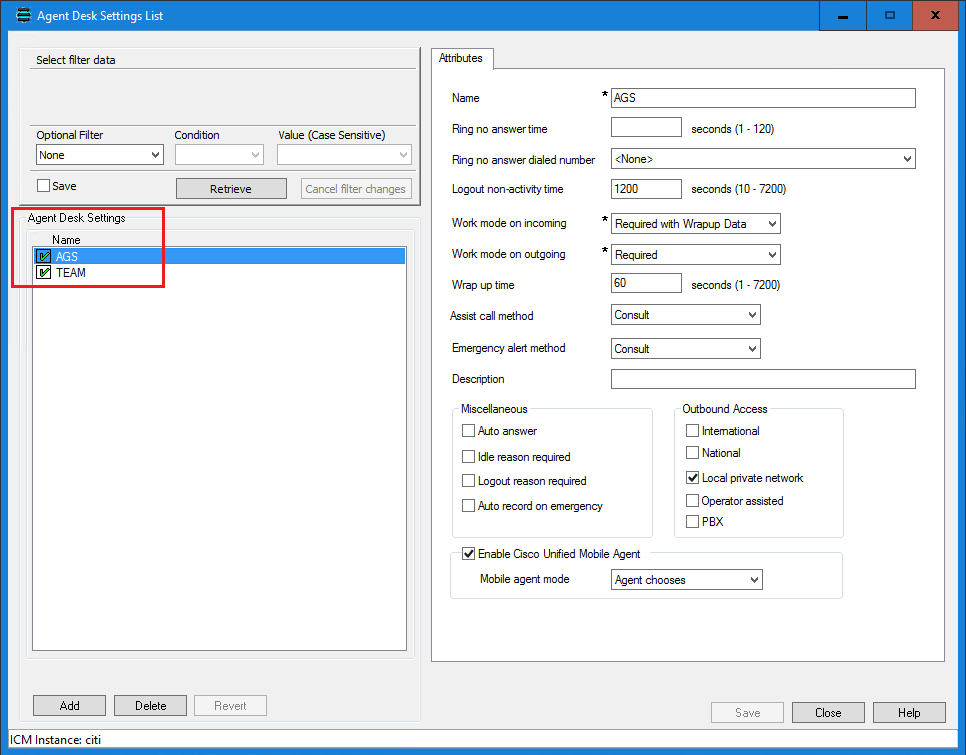

Note: Agent state set is READY or NOT_READY after CVP RNA expires based on the Step 4. and Step 5. configuration respectively
Step 4. Agent state set isNOT_READYafter CVP RNA expires when:
-
In Agent Desk Settings, theRing no answer dialed numberfield is set to blank.
-
You do not enter a value in theRing No Answer timefield.

Step 5 Agent state set isREADY after CVP RNA expires when:
-
In Agent Desk Settings, theRing no answer dialed numberfield is set to blank.
-
You entered a value in theRing No Answer timefield. This value must be at least 2 seconds more than timeout configured at Unified CVP for RNA Timeout.
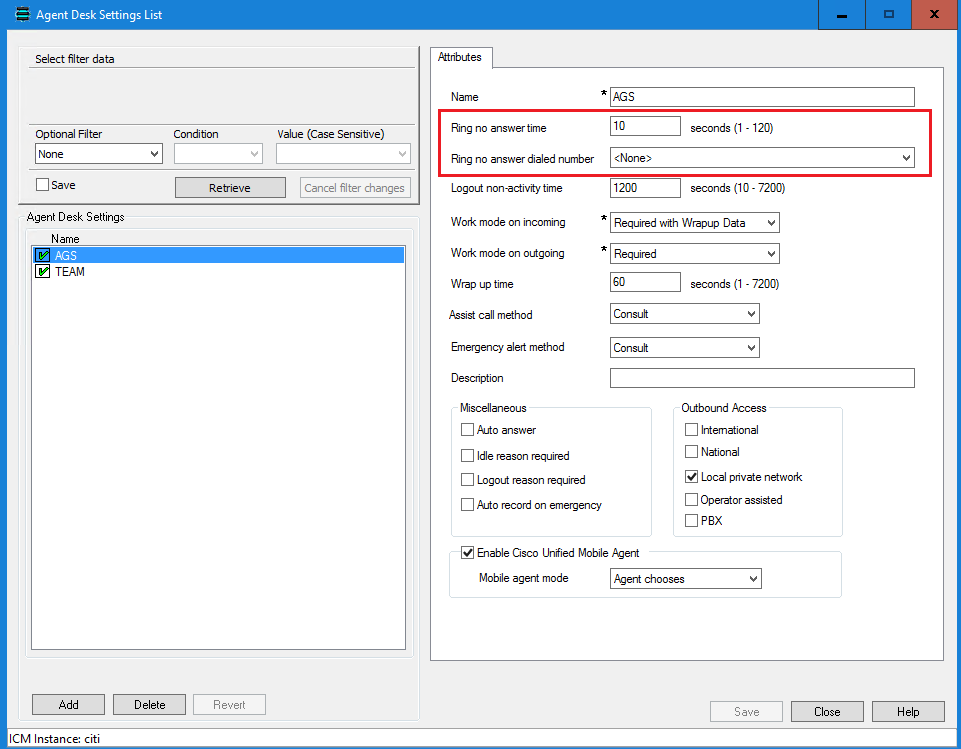

Note: In the example script Scripting for RONA:
1. The Queue node for the skill group that selects the first agent must have Target Requery enabled.
2. Raise the priority of the call so that it moves to the front of the queue.
PCCE - Agent Desk Setting
Step 1. Open the CCEAdmin and navigate to Desktop.
Step 2. On Desktop select the Desk settings that the agent has configured.
Step 3. Select either Not Ready or Ready on the Agent State after RONA field.
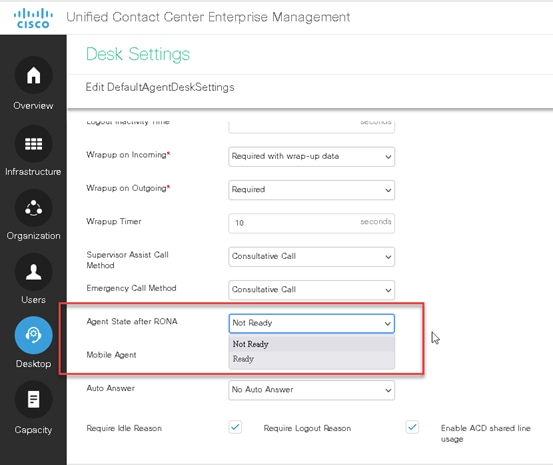
CVP- OAMP Console (for UCCE only)
Step 1. Access OAMP Web Page.
Step 2. Navigate System -> Dialed Number Pattern.

Step 3.See list of patterns if you added already, or you can add those new end points used for Agent extension.
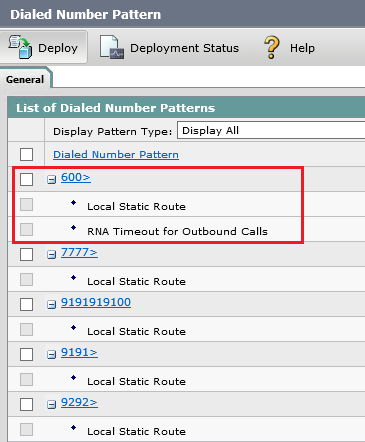
Step 4. Locate the "Patterns for RNA timeout on outbound SIP calls" - this is where you add the time CVP to wait prior to initiating the Target re-query in ICM. Add the timer - 12 second and hit SAVE and DEPLOY at the bottom. You don't have to re-start CVP.


PCCE - RNA Timeout Configuration
Step 1. Open the CCEAdmin and navigate to Routing Pattern.
Step 2. Select Route Settings.
Step 3. Add the timer to the RNA Timeout field.
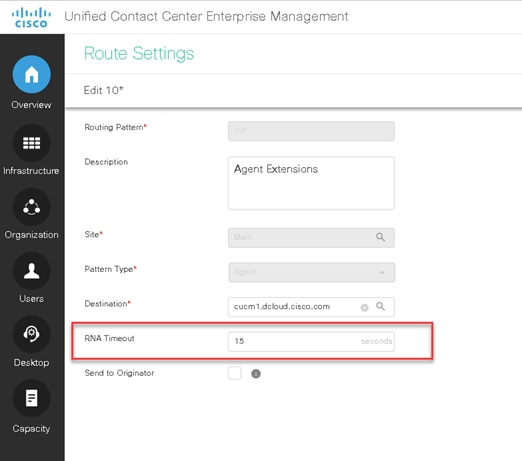
CCE - Scripting
Step 1. Access Script Editor in Adminstrator server.
Step 2. See list of Scripts if you added already, or you can create a new script.
Step 3. Navigate File -> New.

Step 4. Change the Queue Type properties by righ click on the Queue to Skill Group node to enable Target Requery and set the higher Priority.
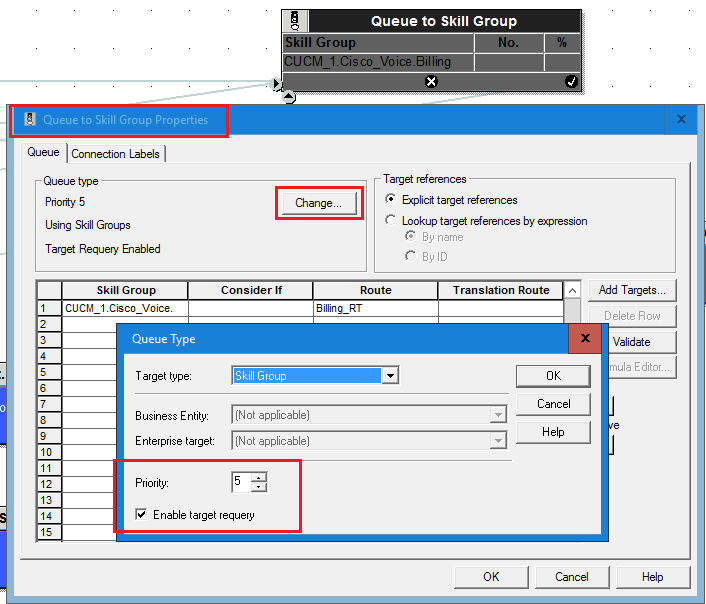
Step 5.Configure RequeryStatus variable in the script to validate the router requeuery status.
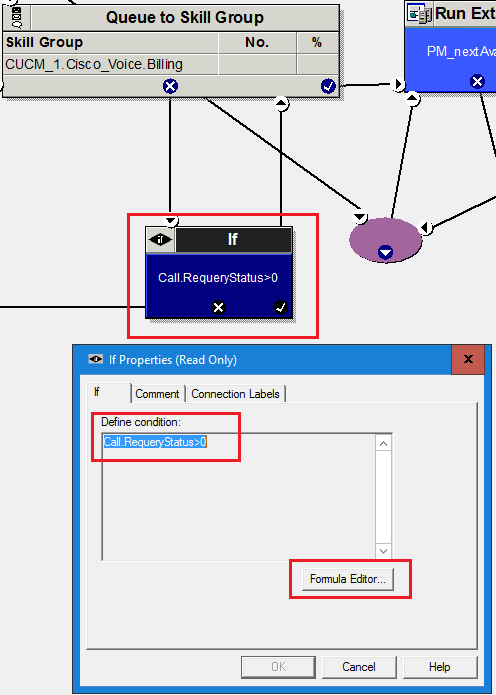
If there is an available agent, the Queue node selects the longest available agent from the configured skill groups. If there is no available agent, the script then queues the call with a priority set in the node and continues down the success exit of the node. When an agent becomes available, the Unified ICM always selects the longest queued call from the ones with the highest priority. The RONA mechanism works as follows:
- The Queue node selects an agent.
- If the agent does not answer the call, then the script exits through the failure terminal of the Queue node.
- The If node tests the RequeryStatus variable. If it has value of greater than zero, this is a requery call and the script re-queues the call.
- In the Scripting for RONA example above, it also sets a flag using a call variable for reporting purposes.
- Assuming that there are no agents available, the Queue node immediately exits through the success terminal.
- If this is a required call, It increases the Queue Priority of the call so that it is handled before any other calls in queue.
- It then enters the normal wait loop with RunScripts
Router Requery is triggered by the routing client (the CVP) when a No-Answer-Timer setting (RNATimeout) expires on CVP. After the CVP VB RNATimeout expires the CVP --> VRU PG sends anEventReport = No Answerto the router. The router picks another target according to the routing script and sends the Connect message to the CVP. The target might be another agent or it might be a VRU label to re-queue the call.
- The No Answer timer for Router Re-query is not controlled by the ICM, but by the switching fabric, which is the CVP in this case. CVP has a configurable No Answer timer, called RNATimeout. Set the RNATimeout to the desired number of seconds that the agent phone should ring before being taken away. In any case, this timeout should be longer than the RONA time-out set in the Agent Desk Settings.
- Enable Requery on the node in the script that selects the first agent. Depending on the type of node used, the Requery mechanism select a new target from the available agents or requires additional scripting. The ICM Script Editor Guide describes how Requery works for the different nodes.
Note: Script design is outside the scope of this document. This only explains the minimum step needed to requeue the call. For more details on this, see Scripting and Media Routing Guide for Cisco Unified ICM/Contact Center Enterprise
UCM - No Answer Ring Duration
Step 1. Access the DN of each Agent Extension and verify the call forward Ring No Answer timer which is 20 seconds by default.
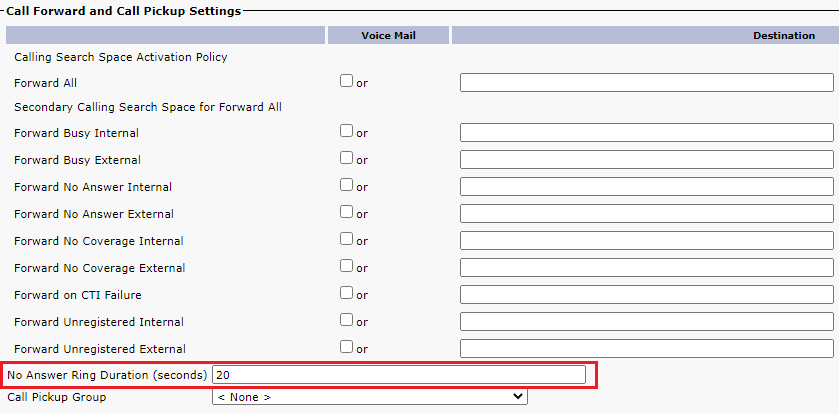















 Feedback
Feedback